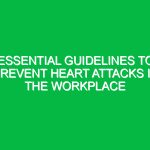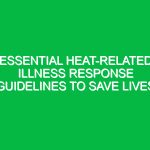“`html
Must-Know Heat and Cold Protection Guidelines to Ensure Worker Safety
Good morning team,
Today, we’re going to discuss an essential aspect of our Workplace Safety: heat and cold protection guidelines. Understanding how to protect ourselves from extreme temperatures is vital for our health and well-being on the job. These guidelines are not just Regulations; they are necessary practices to keep us safe while we work in varying environmental conditions.
As we dive into this topic, remember that our safety is a shared responsibility, and being aware of these guidelines can make a significant difference in preventing heat-related illnesses and cold stress. Let’s get started!
Understanding Heat and Cold Protection Guidelines
Heat and cold protection guidelines refer to the Safety Measures and practices designed to protect workers from extreme temperatures. These guidelines are crucial in ensuring that employees remain safe and productive in varying weather conditions, whether it’s the sweltering heat of summer or the biting cold of winter.
Ignoring these guidelines can lead to serious health issues such as heat exhaustion, heatstroke, frostbite, or hypothermia. It’s essential to recognize that temperature extremes can significantly impact our performance and safety on the job.
One common misconception is that only outdoor workers are at risk from temperature extremes. In reality, indoor workers can also be affected, particularly in unregulated environments. Therefore, understanding these guidelines is vital for everyone.
Key Hazards, Risks, and Safety Considerations
Let’s look at some specific hazards and risks associated with heat and cold exposure:
- Heat Hazards: Prolonged exposure to high temperatures can lead to heat-related illnesses. Symptoms can range from mild heat cramps to severe heat exhaustion or heatstroke, which can be life-threatening.
- Cold Hazards: Cold exposure can result in frostbite and hypothermia. Recognizing the signs of these conditions early can prevent long-term injuries.
- Environmental Factors: Humidity, wind chill, and direct sunlight can exacerbate the Effects of heat and cold on the body.
Ignoring these risks can lead to real-world consequences, such as workplace accidents due to reduced concentration, increased fatigue, and severe health emergencies. The impact of these hazards can not only affect individual employees but can also disrupt operations and harm overall workplace morale.
Best Practices, Procedures, & Actionable Advice
Now let’s discuss the Best Practices to help protect ourselves from extreme temperatures:
Heat Protection Guidelines
- Hydration: Drink plenty of water throughout the day. Aim for at least 8 ounces every 20 minutes, especially during strenuous work.
- Rest Breaks: Take regular breaks in a cool, shaded area. This practice helps your body recover from the heat.
- Appropriate Clothing: Wear lightweight, loose-fitting clothing. Light colors help reflect heat and keep you cooler.
- Monitor Your Health: Be aware of your body’s signals. If you or a coworker feels dizzy, nauseous, or excessively fatigued, take immediate action.
Cold Protection Guidelines
- Layering: Wear multiple layers of clothing to trap heat. Start with moisture-wicking fabrics, add insulating layers, and finish with a waterproof outer layer.
- Warm-up Exercises: Perform light exercises to keep your blood circulating and your body warm.
- Take Breaks: Seek shelter from the cold frequently to warm up. This practice is crucial in preventing hypothermia.
- Buddy System: Work with a partner to monitor each other for signs of cold stress.
Real-World Examples
Consider a case from last summer when a worker ignored signs of heat exhaustion. Despite feeling dizzy and fatigued, he continued working. He ultimately required medical attention due to heatstroke. This incident could have been avoided with proper hydration and regular breaks.
In another case, a worker in a cold storage facility suffered frostbite because he was not wearing appropriate gloves. This incident underscores the necessity of wearing the right gear for the conditions.
Regulations, Standards, and Compliance
It’s important to be aware of the regulations governing heat and cold protection, including:
- OSHA Guidelines: The Occupational Safety and Health Administration (osha) has set Standards for working in extreme temperatures. Familiarizing ourselves with these regulations can lead to better compliance and safety.
- Company Policies: Our company has specific policies regarding heat and cold exposure. Ensure you know these policies to maintain compliance and protect yourself and your coworkers.
Compliance with these standards is not just a legal obligation; it is also a commitment to creating a safe work environment for everyone.
Employee Engagement & Discussion
Now that we’ve covered the guidelines, let’s open the floor for discussion:
- What experiences have you had regarding heat or cold exposure on the job?
- What strategies do you find most effective for staying safe in extreme temperatures?
- How can we improve our current practices to better protect each other?
Your input is valuable, and discussing these experiences can help us all learn and improve our safety practices.
Conclusion & Key Takeaways
In conclusion, understanding and adhering to heat and cold protection guidelines is crucial for ensuring our safety at work. Remember the following key points:
- Stay hydrated and take breaks in extreme heat.
- Dress appropriately for cold weather and monitor your body’s signals.
- Familiarize yourself with OSHA and company safety standards.
- Engage with your coworkers about safety practices and experiences.
Your health and well-being are our top priorities. Let’s commit to applying these guidelines to ensure a safe and productive work environment. Thank you all for your attention and dedication to safety!
“`


